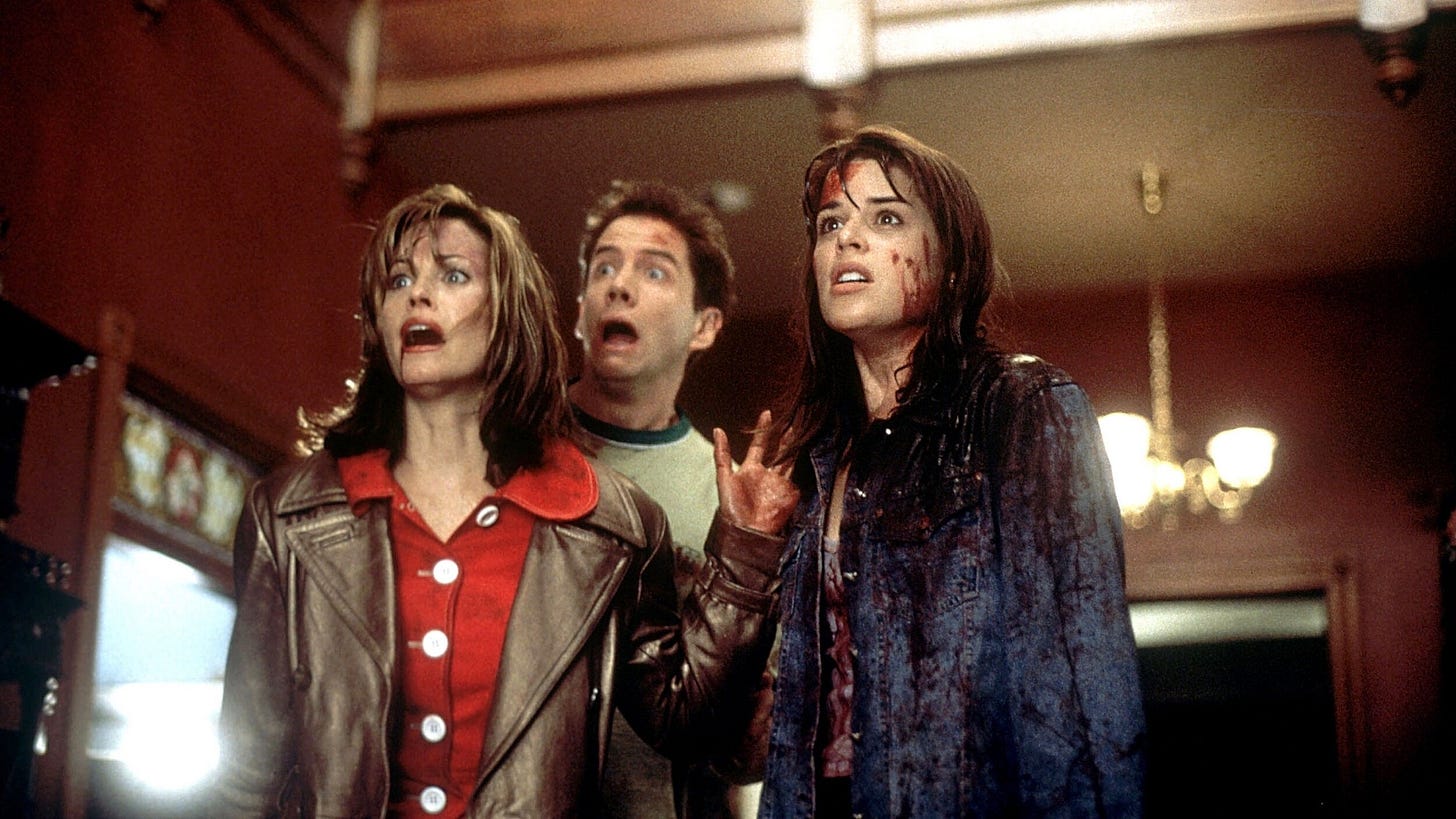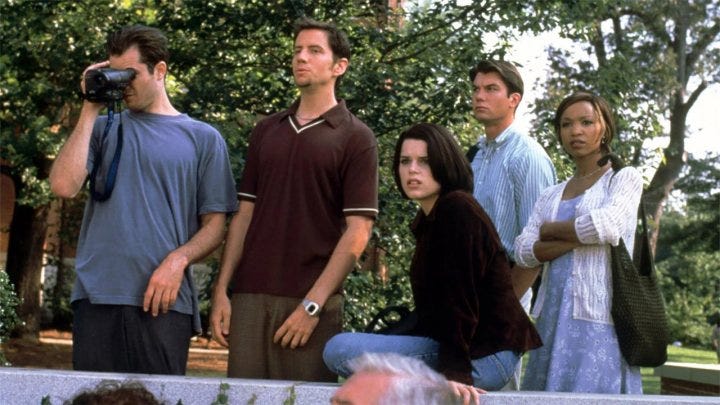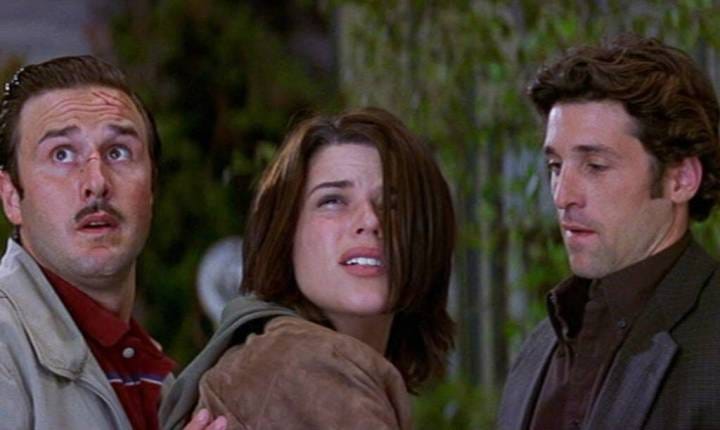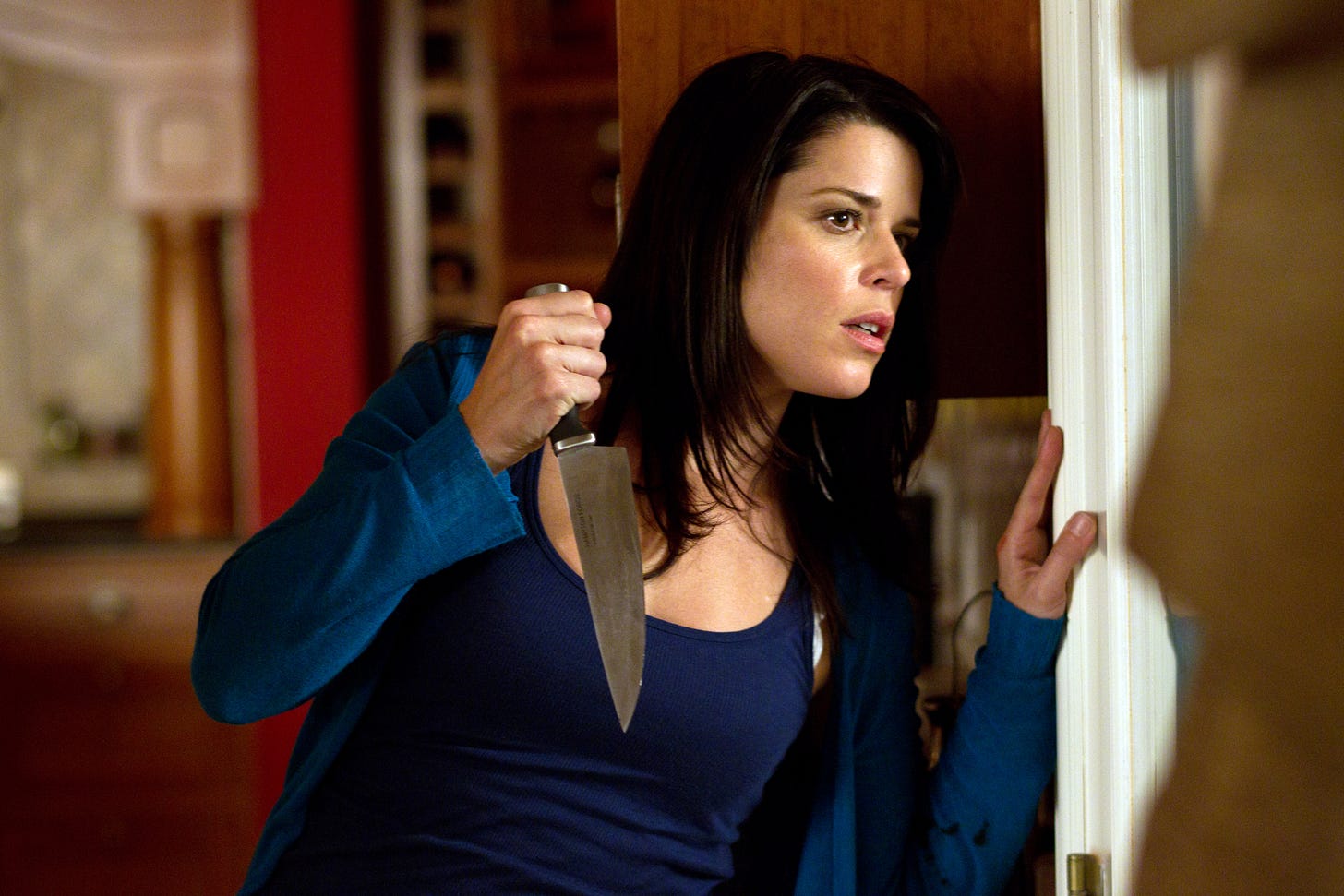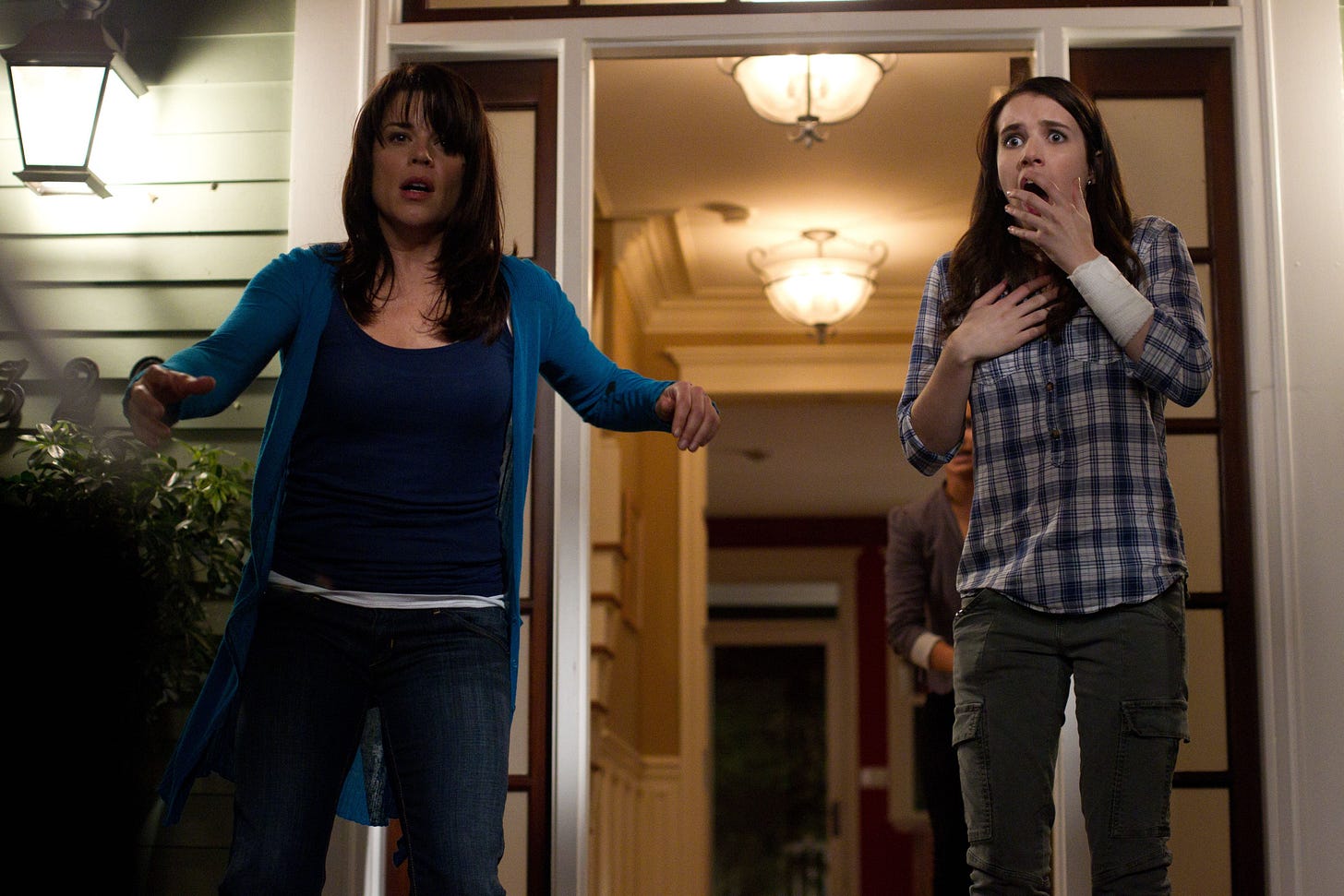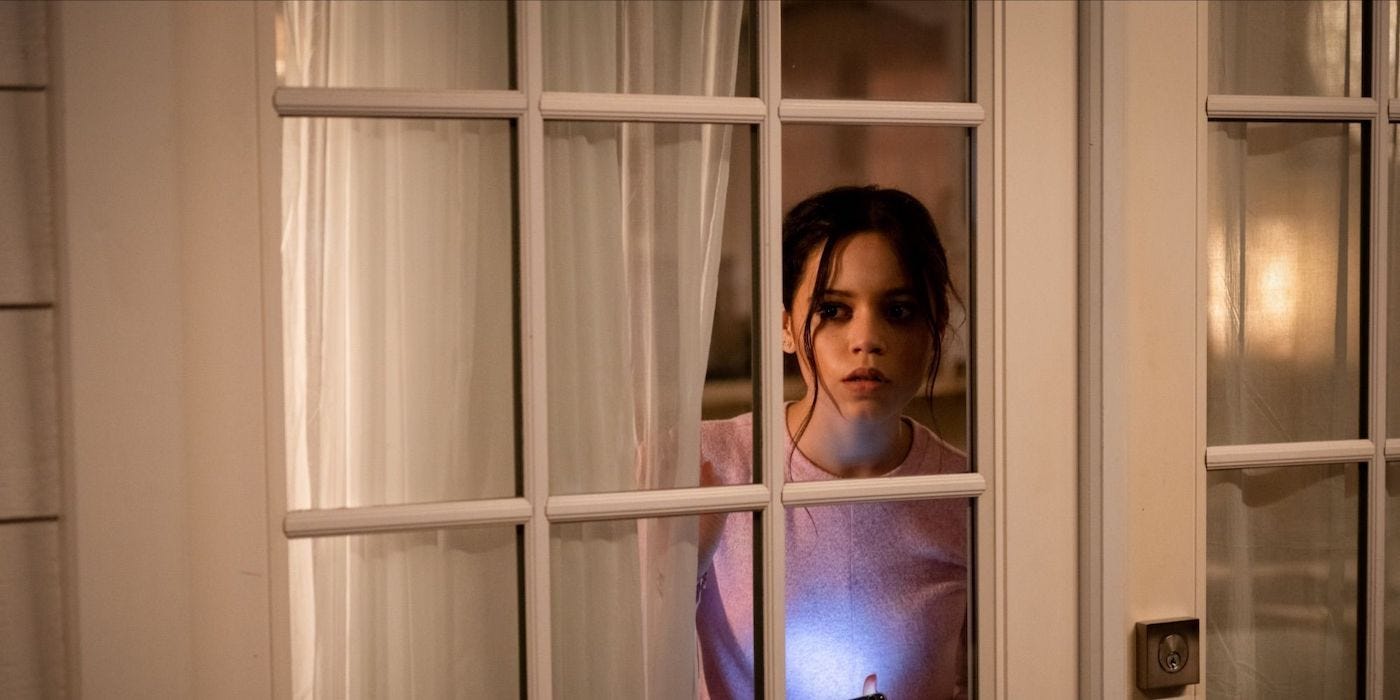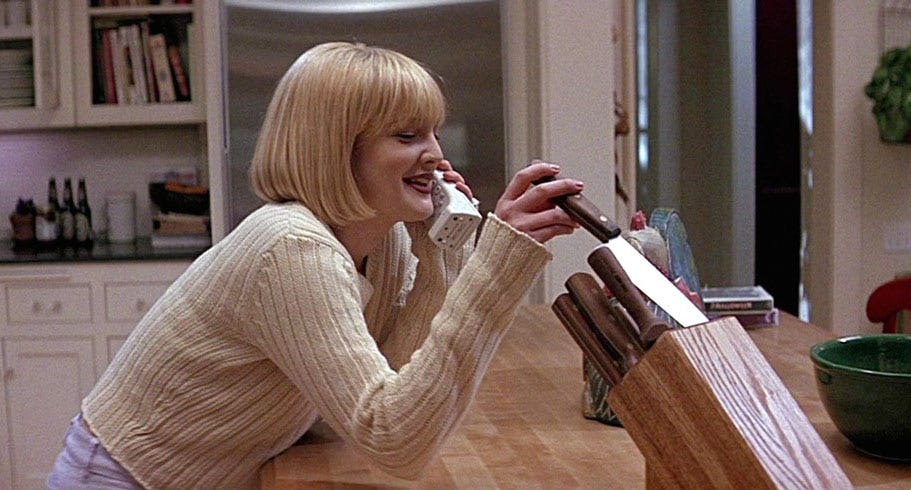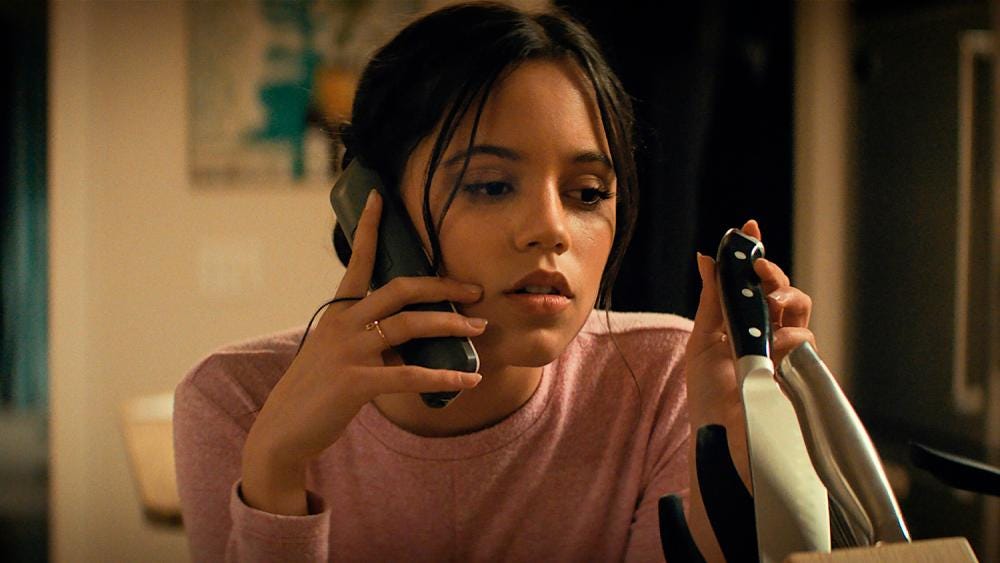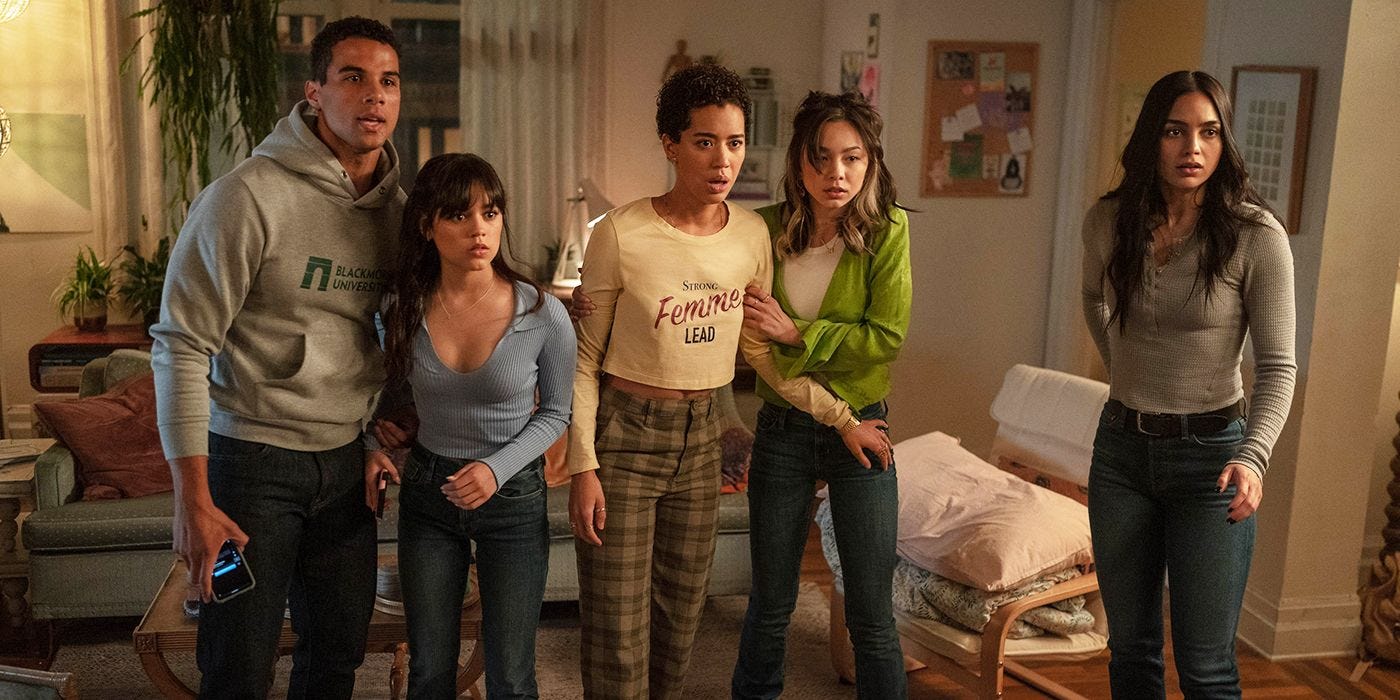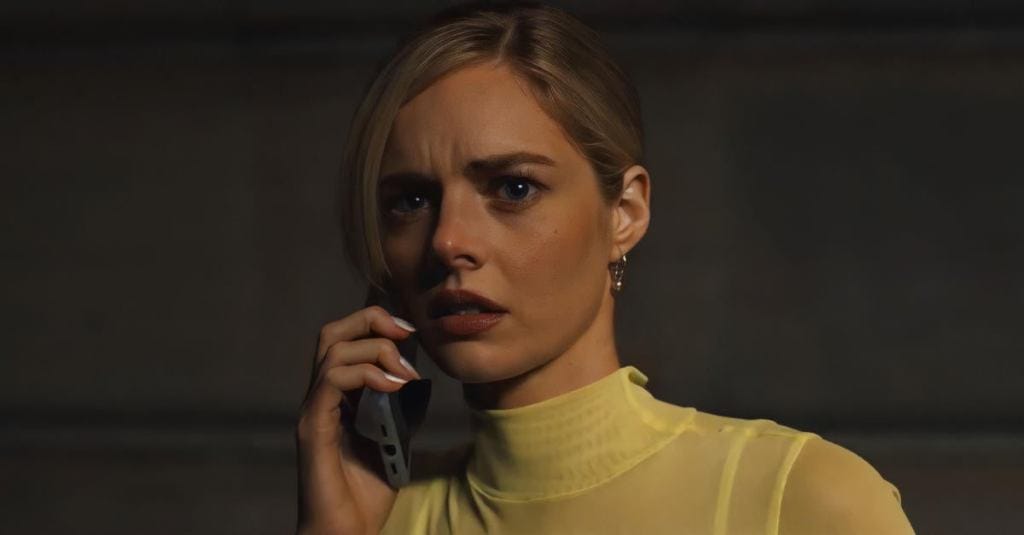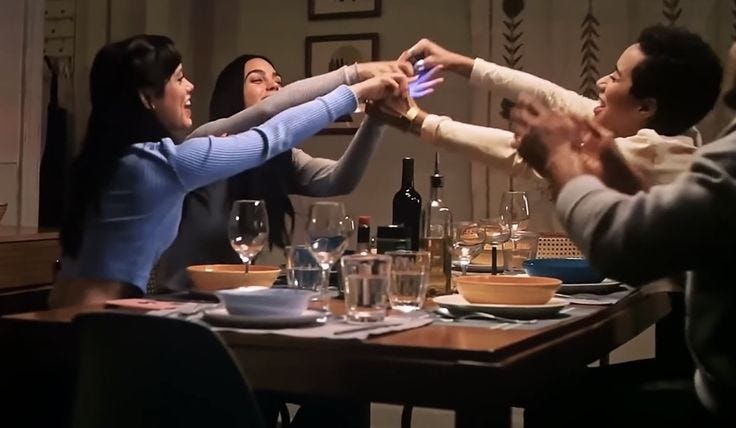**spoilers ahead for Scream (1996)**
Scream (1996) has long remained The Only Slasher I Like. For those of you who haven’t seen it, a quick recap: a masked killer called Ghostface starts cutting up teenagers in Woodsboro, California, leaving Sidney Prescott (played by Neve Campbell), her film geek bestie Randy Meeks (played by Jamie Kennedy), tabloid journalist Gale Weathers (played by Courteney Cox), and local cop Dewey Riley (played by David Arquette) as the primary survivors.
Penned by Kevin Williamson, the mastermind behind iconic teen dramas Dawson’s Creek (1998-2004) and The Vampire Diaries (2009-2017), Scream enlivened a genre then on its last severed leg. Horror reached a zenith in the 1980s after John Carpenter created a cult classic in Halloween (1978). On its heels, films from Friday the 13th (1980) to Nightmare on Elm Street (1984) established a primary place in the cultural zeitgeist before starting to grow tired; too many successive sequels, paired with constant reiterations of the same tropes, rendered the genre predictable — until Scream.
As Roger Ebert puts it in his review of Scream 2 (1997): “Scream was a revolutionary film, the first horror movie in which the characters had seen other horror movies, knew all the cliches, and tried not to make the obvious mistakes.” It broke new ground by taking a self-aware approach to its genre, leaning into mystery as much as murder, and emphasizing character over kills. In an LARB essay, Temple University Assistant Film Studies Professor Kartik Nair acknowledges how, for many, the movie “administered a different kind of jump scare…brought not just a killer but a way of life into view: a life in which films could be studied.”
I’ve held off on watching the full franchise in the past, but finally caved and dipped in a toe, then a leg, over the last week.
Let’s get into it:
Scream 2 (1997, dir. Wes Craven) — Scream 2 (1997) opens a couple years after the events of the first film, with Sidney Prescott (played by Neve Campbell) and Randy Meeks (played by Jamie Kennedy) now students at the fictional Windsor College in Ohio. A big screen adaptation of the Woodsboro murders called Stab has hit screens, and someone new picks up Ghostface’s mask. As Ebert describes: “Like all sequels, this one is a transparent attempt to cash in on the original — but, of course, it knows it is, and contains its own learned discussion of sequels. The verdict is that only a few sequels have been as good as the originals; the characters especially like Aliens (1986) and The Godfather, Part II (1974). As for Scream 2, it’s…well, it’s about as good as the original.”
Where to Watch: Max (subscription), Amazon Prime Video ($3.79), Hulu (premium subscription), YouTube (primetime subscription)
Scream 3 (2000, dir. Wes Craven) — The Scream franchise’s The Godfather, Part III (1990), with nonchalant casting couch jokes that aged like unrefrigerated whole milk, especially in a Harvey Weinstein-produced film. Scream 3 (2000) still makes for a worthy watch though, in large part because of Courteney Cox and David Arquette’s chemistry. (ICYMI: the now-exes famously met working on the first film and were married by the third after director Wes Craven sat down Arquette and told him to get his shit together.)
Scream 3 parodies the parasitic undercurrent that pulses beneath Hollywood, but errs too far toward humor rather than heart compared to the prior installments. The plot picks up one year after the events of the prior film, with Sidney Prescott (played by Neve Campbell) living in self-imposed isolation in a rural part of California. When the production of the latest film in the Stab series, Stab 3, becomes plagued by Ghostface murders, Sidney gets lured out of hiding to Los Angeles, where she, Gale Weathers (played by Cox), and Dewey Riley (played by Arquette) find themselves reconsidering and re-contextualizing the events of the prior films. Initially intended as the grand finale to a trilogy, Scream 3 caps off the initial films well in terms of overarching narrative, but its quality and characterization waver.
Bogged down with projects, Kevin Williamson passed the writing baton to Ehren Kruger for this script. Kruger initially worked off an outline from Williamson, then abandoned it under pressure to turn down the violence in the wake of the Columbine High School massacre, resulting in the franchise’s most unserious iteration, a tonally off film a la Gilmore Girls season seven defined by Roger Ebert as “an interlacing of irony and ‘gotcha!’ scenes.” As Ebert describes: “The identity of the killer in Scream 3…is absolutely unguessable. Why? Because the identity is absolutely arbitrary. It could be anyone in the movie, or (this would be a neat twist) none of the above. The characters are so thin, they’re transparent. They function primarily to scream, split up when they should stick together, go alone into basements and dark rooms, and make ironic references to horror cliches and earlier movies in the series.”
Where to Watch: Max (subscription), Amazon Prime Video ($3.99), Hulu (premium subscription), YouTube (primetime subscription)
Scream 4 (2011, dir. Wes Craven) — Scream: The Millennial Remix, Scream 4 (2011) picks up ten years from its predecessor with cameos from peak 2011 teen actors ranging from Lucy Hale to Shenae Grimes to Kristen Bell. A few folks on Letterboxd liken the look and feel to a Disney Channel original movie, an observation partially just reflective of the early 2010s’ mainstream movie aesthetic, but an astute one nonetheless. Scream 4 reimagines the franchise in a world with iPhones and nascent social media, providing a predictive peek into the influencer culture that now dominates over a decade later.
Scream 4 centers on Sidney Prescott (played by Neve Campbell) embarking on a temporary return to Woodsboro. Ten years have passed since someone last donned Ghostface’s mask, and the town marks Sidney’s last stop on the tour for her debut grief memoir, Out of Darkness. Dewey Riley (played by David Arquette) now watches over Woodsboro as sheriff, while Gale Weathers — now Riley — (played by Courteney Cox) struggles with small-town writer’s block. The night before Sidney’s return, on the 15th anniversary of the original killings, two teenage girls get mutilated. When evidence gets planted in Sidney’s car, she, Dewey, and Gale find themselves entrapped in a new investigation.
This iteration marks an improvement from its predecessor, with some people — though not yours truly — even putting it on par with Scream 2 (1997). Time invigorates the relationships between the original trio with new, compelling contours; for instance, adhering to his status as sheriff, Dewey refuses to share details around the murders with Gale, sending her spinning into a solo side quest. But where historical context couples with fresh dynamics to cement continued investment in Sidney, Dewey, and Gale, the new generation characters, as I see it, lack a comparable level of depth. As Roger Ebert puts it: “The actors do what they can in a film that doesn’t care about human insights. The characters are almost preternatural in their detachment…the locals are almost catatonic in their ability to carry on dialogue.”
Where Scream 3 (2000) shies away from gore, Scream 4 leans into its status as a slasher. From my perspective, however, it errs too far in the opposite direction of its predecessor, losing a lot of the humor and heart that shapes earlier scripts — all without a comparable fear factor. As journalist Phelim O'Neill summarizes in a review for The Guardian: “Scream 4 is not without enjoyment. It's good to see familiar characters back and the opening moments are quite spirited. But it's a film about horror films without being a horror film itself…reliant…on loud noises to provide the shocks the plot can't deliver.”
Where to Watch: Max (subscription), Amazon Prime Video ($3.99), Hulu (premium subscription), YouTube (primetime subscription)
Scream (2022, dir. Tyler Gillett and Matt Bettinelli-Olpin) — Now, we’re back in business. Each movie in the Scream franchise seeks to subvert the tropes associated with what it represents; for instance, the first film famously comments on the “rules” of traditional horror at large, while the second iteration repeatedly references the trappings of sequels. Scream (2022) plays with the notion of a “re-quel,” the kind of reboot popularized by the 90s nostalgia that has plagued the past decade.
Scream (2022) opens with a familiar scene: a teenage girl home alone in Woodsboro, ensnared in a treacherous game of film trivia with an unknown caller. Where Drew Barrymore’s Casey answers questions about the very real horror canon that dominated the prior decade, Tara Carpenter (played by Jenna Ortega) gets grilled on the in-universe Stab series, now a fictional set of eight films based on and spanning beyond the original murders. But unlike Casey, Tara inhabits the present day. She Googles the answers to Ghostface’s questions; texts updates to her best friend, Amber (played by Mikey Madison); and uses a mobile app to lock her doors. The trappings of technology ensure her initial survival — but barely. This opening sequence establishes the framework of the film, which reanimates the beats of its original through a new cast with fresh twists.
Compared to the preceding sequels, save for Scream 2 (1997), Scream (2022) edges closest to the ideal balance of humor, heart, and gore that shapes the original film. As Brian Tallerico describes in his review for RogerEbert.com: “Whereas the first script by Kevin Williamson turned the kind of conversations that fans had about John Carpenter and Wes Craven in school cafeterias and coffee houses into something daring and riveting, the new script by James Vanderbilt and Guy Busick exists in a world where those conversations happen on a much larger scale in Discord chats, Reddit threads, and fan conventions. It’s a horror film for a world in which everyone has an opinion on horror films. Luckily, it smartly balances references to the original movies in a way that (mostly) avoids the self-aware smugness that has killed many a ‘re-quel,’ delivering a product that feels consistent with the first four movies but distinct enough to have its own voice.”
Scream (2022) succeeds, from my perspective, because of its earnest intelligence. It avoids that off-putting sense of “self-aware smugness” Tallerico references, a defining factor in the fourth film, in large part, through gut-wrenching reprisals from Neve Campbell, Courteney Cox, and David Arquette of their original roles as Sidney Prescott, Gale Weathers, and Dewey Riley, respectively. The relationship between Tara and her sister, Sam (played by Melissa Barrera) carries the remaining emotional core of the film, ensures an audience connection to characters new and old that Scream 4 (2011), as I see it, lacks; while Ortega, as I see it, outperforms Barrera, the pair embody a genuine bond that helps ground the movie even as it “[rises] to the rafters in its bonkers final act” (in the best way), per Tallerico.
Where to Watch: Netflix (subscription), YouTube (primetime subscription), Amazon Prime Video ($3.79), Paramount+ (subscription)
Scream VI (2023, dir. Tyler Gillett and Matt Bettinelli-Olpin) — Like its predecessor, Scream VI (2023) focuses on the Carpenter sisters. A year after the latest Woodsboro murders, Sam (played by Melissa Barrera, who seriously ups her game this time around) and Tara (played by Jenna Ortega) have moved to New York (read as: various Canadian locations poorly dressed up as New York) with Chad and Mindy Meeks-Martin (played by Mason Gooding and Jasmin Savoy Brown, respectively), Randy’s nephew and niece who appear in the prior film. Tara, Chad, and Mindy attend the fictional Blackmore University (read as: McGill University in Montreal), where Sam watches over Tara — often with too tight a leash.
When a string of killings starts up at the college, the self-described “core four” find themselves entrapped in “a sequel to the re-quel.” Adding fuel to the fire, a rumor that Sam orchestrated the most recent Woodsboro killings makes the rounds on Reddit. The idea begins as a seed and spirals, evolves from a niche narrative to one reiterated on nighttime news. This layer of discourse broadens the world of “Discord chats, Reddit threads, and fan conventions” that the fifth film inhabits, and, where Scream 4 (2011) offers a prescient look into contemporary creator culture, Scream VI examines the tenuous relationship to truth that accompanies the modern condition.
In his LARB essay, Nair places Scream VI in dialogue with Scream (1996) through the prism of his personal experience — first as a teenager in Delhi, now as a film professor at Temple University. He writes: “Scream VI begins, like Scream, with a close-up of a ringing telephone…The killer’s first call is to a woman seated at a bar in a crowded city restaurant, not to a girl alone in her suburban house. [Film professor ‘teaching a class on 20th-century slashers to a heap of hungover 19-year-olds’] Laura Crane (played by Samara Weaving) is here for a date…By shifting the age of the ‘first girl’ between Scream and Scream VI…the franchise recognizes its original fanbase. But the shift is also more specific. Across the franchise’s many films, the interest in horror films is represented as increasingly institutionalized: what was teenage telephone chatter in Scream is now a professional identity in Scream VI.”
Scream VI’s characters acknowledge the emergence of horror as an establishment. They comment on their place “in a franchise,” voicing their collective concern with its implicit obliteration of the “rules.” Screenwriters James Vanderbilt and Guy Busick toe a careful line, avoiding meta-referential overkill (no pun intended). As Benjamin Lee puts it in his review for The Guardian: “Tone has always been key with the Scream movies, an unusual melange of self-referential snark, Scooby Doo mystery-solving, gory horror, and far-fetched family soap…While Scream VI is far less fixated on a thesis than the fifth was, it’s still clever enough to comment on franchise fatigue and the repetitive grind of trauma without feeling as didactic or as smug as so many more superficially high-minded horror films.”
Beyond the conceptual, the chemistry between the “core four” cements Scream VI as a worthy watch. Vanderbilt and Busick cultivate a depth of character comparable to the first two films, even if the level of wit somewhat wanes compared to a Williamson script. Sam, in particular, sees her demons darken after leaving Woodsboro, carving out a fresh path for the film that maintains ties to the franchise’s original premise. Lee goes on: “Barrera [as Sam]…feels freer [in Scream VI compared to Scream (2022)], overcoming some of her soapier acting impulses, and fostering a strong sibling dynamic with Ortega [as Tara], again a standout. While we might have left the fifth film worried that the newer generation would ever be able to capture the same long-running chemistry as their predecessors, there’s little doubt here, the ‘core four’ as they call themselves proving both charming and heartfelt.” +1!
Where to Watch: YouTube (primetime subscription), Amazon Prime Video ($3.99), Paramount+ (subscription)
Okay, now that you’ve made it to the end — TL;DR my official ranking is Scream (1996), Scream 2 (1997), Scream VI (2023), Scream (2022), Scream 3 (2000), Scream 4 (2011). Scream 4 is probably an objectively better movie than Scream 3, as I mentioned above, but I ultimately had more fun watching the latter. Just one woman’s opinion!
Stay tuned for thoughts on The Substance (2024), In the Cut (2003), and more in the October Movie Review. See you at the end of the month!
xo,
Najet





